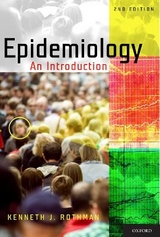
Epidemiology
An Introduction
Seiten
2002
Oxford University Press Inc (Verlag)
978-0-19-513554-1 (ISBN)
Oxford University Press Inc (Verlag)
978-0-19-513554-1 (ISBN)
- Titel erscheint in neuer Auflage
- Artikel merken
Zu diesem Artikel existiert eine Nachauflage
Offers an account of thinking on epidemiologic study design, data analysis and interpretation. This book begins with an introduction to causal thinking and causal inference, leading into measures of disease occurrence and measures of effect. It also describes how to deal with confounding, the role of chance, and the exploration of interactions.
In the past thirty years, epidemiology has matured from a fledgling scientific field into a vibrant discipline that brings together the biological and social sciences, and in doing so, draws upon disciplines ranging from statistics and survey sampling to the philosophy of science. These areas of knowledge have converged into a modern theory of epidemiology that has been slow to penetrate into textbooks, particularly at the introductory level. "Epidemiology: An Introduction" closes the gap. It begins with a brief, lucid discussion of casual thinking and causal inference and then takes the reader through the elements of epidemiology, focusing on the measures of disease occurrence and causal effects. With these building blocks in place, the reader learns how to design, analyze and interpret epidemiologic research studies, and how to deal with the fundamental problems that epidemiologists face, including confounding, the role of chance, and the exploration of interactions. All these topics are layered on the foundation of basic principles presented in simple language, with numerous examples and questions for further thought.
In the past thirty years, epidemiology has matured from a fledgling scientific field into a vibrant discipline that brings together the biological and social sciences, and in doing so, draws upon disciplines ranging from statistics and survey sampling to the philosophy of science. These areas of knowledge have converged into a modern theory of epidemiology that has been slow to penetrate into textbooks, particularly at the introductory level. "Epidemiology: An Introduction" closes the gap. It begins with a brief, lucid discussion of casual thinking and causal inference and then takes the reader through the elements of epidemiology, focusing on the measures of disease occurrence and causal effects. With these building blocks in place, the reader learns how to design, analyze and interpret epidemiologic research studies, and how to deal with the fundamental problems that epidemiologists face, including confounding, the role of chance, and the exploration of interactions. All these topics are layered on the foundation of basic principles presented in simple language, with numerous examples and questions for further thought.
1. Introduction to Epidemiologic Thinking; 2. What is Causation?; 3. Measuring Disease Occurrence and Causal Effects; 4. Types of Epidemiologic Study; 5. Biases of Study Design; 6. Random Error and the Role of Statistics; 7. Analyzing Simple Epidemiologic Data; 8. Controlling Confounding by Stratifying Data; 9. Measuring Interactions; 10. Using Regression Models in Epidemiologic Analysis; 11. Epidemiology in Clinical Settings
| Erscheint lt. Verlag | 31.3.2002 |
|---|---|
| Zusatzinfo | 28 line illustrations |
| Verlagsort | New York |
| Sprache | englisch |
| Maße | 156 x 233 mm |
| Gewicht | 349 g |
| Themenwelt | Mathematik / Informatik ► Mathematik |
| Medizin / Pharmazie ► Medizinische Fachgebiete | |
| Studium ► Querschnittsbereiche ► Epidemiologie / Med. Biometrie | |
| ISBN-10 | 0-19-513554-7 / 0195135547 |
| ISBN-13 | 978-0-19-513554-1 / 9780195135541 |
| Zustand | Neuware |
| Haben Sie eine Frage zum Produkt? |
Mehr entdecken
aus dem Bereich
aus dem Bereich
ein überfälliges Gespräch zu einer Pandemie, die nicht die letzte …
Buch | Hardcover (2024)
Ullstein Buchverlage
24,99 €



